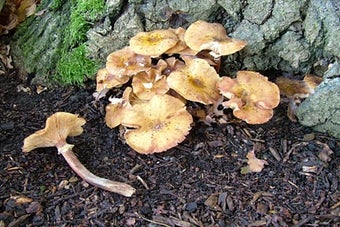
Quick facts
Common name - Toadstools
Scientific name - Many hundreds of different species
Plants affected - A few species cause plant diseases, most are harmless or beneficial
Main symptoms - A ‘typical’ toadstool has a stem and a cap
Caused by - Fungi
Timing - Various
What are toadstools?
A toadstool is the fruiting body of a fungus. There has never been a precise definition as to what makes a fruiting body a toadstool, and there is no clear distinction between toadstools and mushrooms.
- The ‘classic’ image of a toadstool is that of a fruiting body with a stalk and a cap
- The word mushroom is also used for a fruiting body of this type, although this term is also often applied to other types of fungal fruiting bodies such as brackets and puffballs
- The term toadstool has often been applied to poisonous or inedible fruiting bodies, but this is not a universally-accepted definition
- In the same way, just because a fruiting body is referred to in the literature as a mushroom you should not assume that it is edible
- Wear gloves when handling unknown mushrooms, or ensure that you wash your hands afterwards
Symptoms
You may see the following:
- A ‘classic’ toadstool has a stalk and a cap
- Beneath the cap there may be gills (as on a typical supermarket mushroom) or pores
- Size and colour will vary greatly according to the species of fungus producing the fruiting body
- Fruiting bodies may appear on the soil, on lawns, in heaps, or on or close to plants – in fact, in most places in the garden
Control
The appearance of toadstools in a garden should not usually be a cause for concern. You should, however, familiarise yourself with the fruiting bodies of the few species such as Armillaria and Marasmius that can cause problems, as well as the symptoms of the respective diseases that they cause.
Non-chemical control
- The extensive white fungal mycelium sometimes found in soil can have water-repellent properties, preventing water reaching the root system of shallow-rooted plants. If this occurs, the fungal matter should be broken up with a fork
- If stinkhorns are a problem, dig down to see whether there is any woody material in the soil on which the fungus could be feeding. Disposing of this may prevent further growth. Otherwise, try to dispose of the fruiting bodies while they are still in the unopened (and odourless) form of semi-submerged, white ‘eggs’
Chemical control
- Fungicides for control of the toadstool-producing fungi are unavailable and anyway, in the vast majority of cases, would be unnecessary
The Royal Botanic Gardens, Kew will answer general enquiries about mushroom/toadstool toxicity; contact [email protected]. However, in cases of suspected poisoning seek medical attention at an Accident and Emergency Department, taking a sample of the fungus with you.

Biology
- While the toadstool or fruiting body is the most visible sign of the fungus, these are transient structures designed solely for the dispersal of spores
- Many of the fungi produce their fruiting bodies in autumn, although again this will vary with the species. For the rest of the year the presence of the fungus is not as obvious, existing as numerous fine threads or filaments known as hyphae. Together, these make up what is known as the mycelium of the fungus
- Occasionally, when environmental conditions are suitable, prolific growth of mycelium occurs and becomes visible as a white, fungal-smelling growth within the soil or in a heap or bag
- The vast majority of fungi producing toadstools cause no harm to garden plants and should not be a cause for concern
- There are, however, a few exceptions and one of these, honey fungus (Armillaria spp.), is the most damaging disease of garden trees and shrubs
- Some of the fungi causing fairy rings in lawns (e.g. Marasmiusoreades) also produce toadstools
The vast majority of fungal species producing toadstools in gardens are likely to be of two types:
Saprophytes: This group of organisms feeds on dead plant and animal remains and they are usually beneficial to plant growth, as they release minerals and back into the soil and help form its organic humus content. One species found in gardens that may cause offense is the stinkhorn (Phallus impudicus). The fruiting bodies have a thick white stalk and dark head, and the extremely strong odour of decay they produce is often the first indication of their presence.
Mycorrhizae: a term that translates as ‘fungus root’. These fungi form an intimate association with the roots of plants, including many trees and shrubs. This is a beneficial association known as a symbiosis; the fungus derives nutrients from the plant, but the fungal hyphae also grow out from the roots into the soil, enabling the plant to obtain water and nutrients from a much greater area than it could with just its own roots. A well-known example of a mycorrhizal fungus is the poisonous fly agaric (Amanita muscaria) with its bright red cap, spotted with white scales. This is associated with birch and some conifers.




